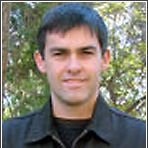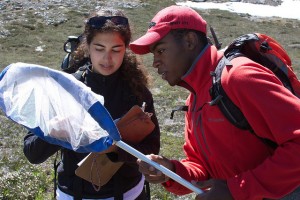Marine life preferences and perceptions among recreational divers in Brazilian coral reefs
By: Giglio, Vinicius J.; Luiz, Osmar J.; Schiavetti, Alexandre TOURISM MANAGEMENT Volume: 51 Pages: 49-57 Published: DEC 2015 | Find with Google Scholar »
|
Dear all,
Firstly – GREAT news on the ERA2015 outcomes – see all the details below, but biology can be very proud of our efforts. We are clearly hugely important in Macquarie’s research standing. Thanks to the ERA champions who helped pull the data together – Mark Westoby, Mariella & Andy Barron. We can celebrate at the department research retreat on Monday at the Botanic Gardens!
Thanks to Grant for standing in for me while I was at the Ecological Society meeting in Adelaide this week and to all unit convenors who got their grades in on time and to Sharyon and her team for pulling it all together for the exam meeting.
The faculty end-of-year function is next Tuesday afternoon – there will be drinks and food and announcements of winners of the research and teaching awards. I hear whispers that biology has done pretty well in the awards department so please come along to cheer the winners and celebrate a great year (you can RSVP here). Also don’t forget to put in your calendar the department’s Christmas Party on Friday 18th December – notices will be going up soon around the corridors! And finally next week we will be saying a fond farewell and thanks to two of our long-standing admin team who are retiring – Marie Howitt & Teresa Potalivo – so please join us for morning tea in the courtyard next Tuesday 8th December from 10.30am.
Finally – Christmas approaches and it’s holiday season. We all deserve a rest occasionally so if you have some leave left over then I encourage you to book some holiday leave through HR Online and you will be refreshed for a great year in 2016!
cheerio
Michelle
General News and Announcements
Great news – ERA2015 outcomes announced
Researchers in biological sciences have demonstrated their excellence through the ERA2015 outcomes. We contribute to a number of Field of Research Codes (FoRCs) in 04 (Biological Sciences), 05 (Environmental Sciences) and 07 (Agricultural and Veterinary Sciences). The assessments are done at 2-digit level and 4-digit level. At the 2-digit level, 04 (Biological Sciences) was rated at 4 (performance above world-standard), 05 Environmental Sciences was rated 5 (outstanding performance well above world standard) and 07 (Agricultural and Veterinary Sciences) was also rated 5. At the 4-digit level, we contributed strongly to scores of 5 for Environmental Science & Management, Ecology, Evolutionary Biology, Genetics, Plant Biology and Neurosciences, and scores of 4 for Ecological Applications, Microbiology, and Zoology. These are fantastic results that reflect our research excellence – well done all!
For Field Workers In Fire Prone Environments
The NSW Rural Fire Service will be offering Bush Fire Awareness training for personnel who require approval to enter an active fire ground in the course of their work. This half day course on December 14th at NSW RFS HQ Lidcombe uses a mixture of audio-visual presentations, group discussion and interactive participation. All participants who successfully complete this course will receive a NSW RFS credential certifying that they have received the appropriate training to enter onto an active fire ground under specified conditions. The course content includes a mixture of wild fire behaviour, suppression strategies and tactics and how personnel working at an incident are organised and communicate with one another. Enquiries to <Ross.Peacock@rfs.nsw.gov.au>.
Ray Duell will now be editing the weekly newsletter. Please send him all your stories.
Visiting Distinguished Professor Jordan Price
Professor Jordan Price is a Visiting Associate collaborating with Simon Griffith on Avian trait evolution. He hails from St. Mary’s College of Maryland.
“My research integrates two disparate fields of biology, animal behavior and molecular evolution, to investigate the evolutionary histories of animal traits including the songs and color patterns of birds. Most of my previous work has focused on New World blackbirds (Icteridae), a diverse family of songbirds found throughout North and South America. At Macquarie I will be working with Dr. Simon Griffith using geographic and climatic data to investigate the origins of behavioral and morphological diversity in Australia’s unique avifauna.”
The Molecular Ecologist is Looking for a Few (More) Good Molecular Ecologists
The Molecular Ecologist has big plans for 2016, and we’re seeking new regular contributors to help make them reality.
We seek contributors with expertise and experience in our core topic, the use of genetic data to understand the past and future of the living world. We’re particularly interested in senior graduate students, postdoctoral researchers, and other working scientists who can discuss basic science on a level that engages our core community of research biologists. Ideal candidates will also be excited to explain fundamental molecular ecology concepts to the general public.
Successful candidates will become regular contributors to the site, which entails
- Coordinating with blog editor Jeremy Yoder and other contributors to provide regular brief updates to the site covering “ecology, evolution, and everything in between”;
- Pitching proposals for longer-form articles to the editor — which, if approved, will be written and published to the site as major features; and
- Assisting with planned efforts to develop independent funding for the site, which will provide a budget to pay writers for feature articles and support website infrastructure.
Contributing to The Molecular Ecologist can be an excellent way to gain familiarity with current molecular ecology research, to establish connections within the scientific community, and to build a portfolio of science writing for a broader audience. We envision that contributing to the blog will be a significant professional development opportunity for early-career evolutionary ecologists, and that contributors will help to build the blog’s role as a community hub for molecular ecology research online. To this end, we are particularly interested in applications from women and from scientists whose racial, ethnic, sexual, or gender identities are underrepresented in science careers.
To apply, please e-mail a brief cover letter explaining why you want to write for The Molecular Ecologist and an appropriate sample of your writing to Jeremy Yoder at <jbyoder@gmail.com>. Applications should be received by the end of the day on 15 January, 2016 to ensure consideration.
http://www.molecularecologist.com/2015/11/were-looking-for-a-few-more-molecular-ecologists/
Plants of the Week!
New South Wales Christmas Bush – Ceratopetalum gummiferum
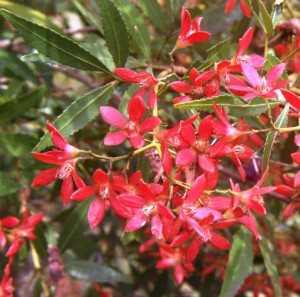
|
Western Australian Christmas Bush – Nuytsia floribunda There is something rather unusual about this photograph of the Western Australian Christmas Bush. Kevin and Alison will donate $1 to the Royal Flying Doctor Service (up to a total of $50) for every person who emails us the correct answer. Answers will have to reach us before 11 am next Monday. Send your answers to: <alison.downing@mq.edu.au> A list of successful entrants’ names will be displayed on the Plant of the Week table next week. |
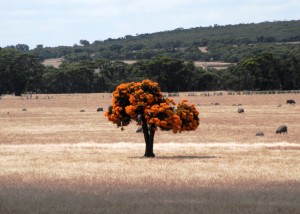 |
Macquarie University Research Development Grant
Congratulations to Teresa Iglesias and Dan Warren who were awarded an MQRDG in order to develop their study on the evolution of brains in marine fish. The project is entitled “Exploring brain evolution in marine fishes: How does ecology and behaviour impact relative investment in different brain areas?”
Presentation Success @ Technet 2015
Prasanth Subramani, Scientific Officer in the Department of Biological Sciences, won the TechNet E-Poster prize for his submission – “Kickstarting Students’ Lab Skills in the Life Sciences.”
Congratulations Prasanth, and well done.
Fieldwork Volunteers Needed
Hi my name is Samiya and I am a PhD student in the Plant Invasion and Restoration Ecology Lab (PIREL). I am looking for someone to accompany me on fieldwork from December 11th – 21st. I am looking to drive along the east coast of Australia down to Anglesea VIC and look for populations of coastal weeds for my PhD project. The ideal candidate should be able to drive an automatic car. Accommodation is provided but unfortunately you will have to pay for your own food. If you are interested in some fieldwork along some picturesque Australian beaches, please contact me at <s.tabassum@hotmail.com>.
What Makes Technicians Happy
The following list was compiled on Senior Technical Manager Rekha Joshi’s door, and presents a window into the minds of Technicians at this time of year!
New Publications
Does the growth response of woody plants to elevated CO2 increase with temperature? A model-oriented meta-analysis
By: Baig, Sofia; Medlyn, Belinda E.; Mercado, Lina M.; et al. GLOBAL CHANGE BIOLOGY Volume: 21 Issue: 12 Pages: 4303-4319 Published: DEC 2015 | Find with Google Scholar »Projecting future expansion of invasive species: comparing and improving methodologies for species distribution modeling
By: Mainali, Kumar P.; Warren, Dan L.; Dhileepan, Kunjithapatham; et al. GLOBAL CHANGE BIOLOGY Volume: 21 Issue: 12 Pages: 4464-4480 Published: DEC 2015 | Find with Google Scholar »The timing of Carcinus maenas recruitment to a south-east Australian estuary differs to that of native crabs
By: Garside, C. J.; Glasby, T. M.; Stone, L. J.; et al. HYDROBIOLOGIA Volume: 762 Issue: 1 Pages: 41-53 Published: DEC 2015 | Find with Google Scholar »Stable recombination hotspots in birds
By: Singhal, Sonal; Leffler, Ellen M.; Sannareddy, Keerthi; et al. SCIENCE Volume: 350 Issue: 6263 Pages: 928-932 Published: NOV 20 2015 | Find with Google Scholar »LipiD-QuanT: a novel method to quantify lipid accumulation in live cells
By: Varinli, Hilal; Osmond-McLeod, Megan J.; Molloy, Peter L.; et al. JOURNAL OF LIPID RESEARCH Volume: 56 Issue: 11 Pages: 2206-2216 Published: NOV 2015 | Find with Google Scholar »PHENOLOGY Spring greening in a warming world
By: Keenan, Trevor F. NATURE Volume: 526 Issue: 7571 Pages: 48-49 Published: OCT 1 2015 | Find with Google Scholar »Giant Australian cuttlefish use mutual assessment to resolve male-male contests
By: Schnell, Alexandra K.; Smith, Carolynn L.; Hanlon, Roger T.; et al. ANIMAL BEHAVIOUR Volume: 107 Pages: 31-40 Published: SEP 2015 | Find with Google Scholar »A virtual reality paradigm for the study of visually mediated behaviour and cognition in spiders
By: Peckmezian, Tina; Taylor, Phillip W. ANIMAL BEHAVIOUR Volume: 107 Pages: 87-95 Published: SEP 2015 | Find with Google Scholar »Dose-dependent effects of metals on gene expression in the sydney rock oyster, Saccostrea glomerata
By: Taylor, Daisy A.; Nair, Sham V.; Thompson, Emma L.; et al. ENVIRONMENTAL TOXICOLOGY Volume: 30 Issue: 9 Pages: 989-998 Published: SEP 2015 | Find with Google Scholar »Putative Predators of Carcinus Maenas in Eastern Australia
By: Garside, C. J.; Coleman, M. A.; Kelaher, B. P.; et al. ESTUARIES AND COASTS Volume: 38 Issue: 5 Pages: 1557-1568 Published: SEP 2015 | Find with Google Scholar »Predation risk predicts use of a novel habitat
By: Bishop, Melanie J.; Byers, James E. OIKOS Volume: 124 Issue: 9 Pages: 1225-1231 Published: SEP 2015 | Find with Google Scholar »Parasitic nematode communities of the red kangaroo, Macropus rufus: richness and structuring in captive systems
By: Lott, M. J.; Hose, G. C.; Power, M. L. PARASITOLOGY RESEARCH Volume: 114 Issue: 8 Pages: 2925-2932 Published: AUG 2015 | Find with Google Scholar »Genetic similarity is broadly associated with genetic polyandry in birds: a comment on Arct et al.
By: Griffith, Simon C. BEHAVIORAL ECOLOGY Volume: 26 Issue: 4 Pages: 970-971 Published: JUL-AUG 2015 | Find with Google Scholar »MOLECULAR DETECTION OF ANTIBIOTIC-RESISTANCE DETERMINANTS IN ESCHERICHIA COLI ISOLATED FROM THE ENDANGERED AUSTRALIAN SEA LION (NEOPHOCA CINEREA)
By: Delport, Tiffany C.; Harcourt, Robert G.; Beaumont, Linda J.; et al. JOURNAL OF WILDLIFE DISEASES Volume: 51 Issue: 3 Pages: 555-563 Published: JUL 2015 | Find with Google Scholar »An Integrative Framework for the Appraisal of Coloration in Nature
By: Kemp, Darrell J.; Herberstein, Marie E.; Fleishman, Leo J.; et al. AMERICAN NATURALIST Volume: 185 Issue: 6 Pages: 705-724 Published: JUN 2015 | Find with Google Scholar »The danger within: the role of genetic, behavioural and ecological factors in population persistence of colour polymorphic species
By: Bolton, Peri E.; Rollins, Lee A.; Griffith, Simon C. MOLECULAR ECOLOGY Volume: 24 Issue: 12 Pages: 2907-2915 Published: JUN 2015 | Find with Google Scholar »A simple way to improve multivariate analyses of paleoecological data sets
By: Alroy, John PALEOBIOLOGY Volume: 41 Issue: 3 Pages: 377-386 Published: JUN 2015 | Find with Google Scholar »Personality in the wild zebra finch: exploration, sociality, and reproduction
By: McCowan, Luke S. C.; Mainwaring, Mark C.; Prior, Nora H.; et al. BEHAVIORAL ECOLOGY Volume: 26 Issue: 3 Pages: 735-746 Published: MAY-JUN 2015 | Find with Google Scholar »Pheromonal control: reconciling physiological mechanism with signalling theory
By: Peso, Marianne; Elgar, Mark A.; Barron, Andrew B. BIOLOGICAL REVIEWS Volume: 90 Issue: 2 Pages: 542-559 Published: MAY 2015 | Find with Google Scholar »Habitat, water quality, seasonality, or site? Identifying environmental correlates of the distribution of groundwater biota
By: Korbel, Kathryn L.; Hose, Grant C. FRESHWATER SCIENCE Volume: 34 Issue: 1 Pages: 329-343 Published: MAR 2015 | Find with Google Scholar »Active but asocial: exploration and activity is linked to social behaviour in a colonially breeding finch
By: McCowan, Luke S. C.; Griffith, Simon C. BEHAVIOUR Volume: 152 Issue: 9 Pages: 1145-1167 Published: 2015 | Find with Google Scholar »Variation in Brain Morphology of intertidal Gobies: A Comparison of Methodologies Used to Quantitatively Assess Brain Volumes in Fish
By: White, Gemma E.; Brown, Culum BRAIN BEHAVIOR AND EVOLUTION Volume: 85 Issue: 4 Pages: 245-256 Published: 2015 | Find with Google Scholar »Marine plastic pollution: using community science to address a global problem
By: Duckett, Paul. E.; Repaci, Vincenzo MARINE AND FRESHWATER RESEARCH Volume: 66 Issue: 8 Pages: 665-673 Published: 2015 | Find with Google Scholar »Community structure of reef fishes on a remote oceanic island (St Peter and St Paul’s Archipelago, equatorial Atlantic): the relative influence of abiotic and biotic variables
By: Luiz, Osmar J.; Mendes, Thiago C.; Barneche, Diego R.; et al. MARINE AND FRESHWATER RESEARCH Volume: 66 Issue: 8 Pages: 739-749 Published: 2015 | Find with Google Scholar »Long-term water stress leads to acclimation of drought sensitivity of photosynthetic capacity in xeric but not riparian Eucalyptus species
Shuang-Xi Zhou, Belinda E. Medlyn, and Iain Colin Prentice. 2015. Long-term water stress leads to acclimation of drought sensitivity of photosynthetic capacity in xeric but not riparian Eucalyptus species.Annals of Botany. doi:10.1093/aob/mcv161 | Find with Google Scholar »In the Media
Robert Kooyman on ABC North Coast’s Mornings Program
Robert Kooyman from the Department of Biological Sciences spoke on ABC North Coast’s Mornings program about climate change research and economics, and a study on peaches. See page 3 of the report.
Michelle Power on 666 ABC Canberra
Dr Michelle Power from the Department of Biological Sciences was interviewed on 666 ABC Canberra’s Breakfast program about the rise in cases of cryptosporidium in public pools. See page 7 of the report.
1 Minute Round-up: Aquatic Animal Telemetry: A Panoramic Window into the Underwater World
Climate Change is Killing Our Trees
1 December 2015
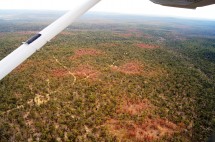
In a report to be released by the Ecological Society of Australia, Dr Niels Brouwers from Murdoch University, Dr Melanie Zeppel from Macquarie University, and colleagues from the USA, suggest changes in climate are reducing tree growth and health.
“In Western Australia we found that more than 25 per cent of mature trees across 7000 hectares of forest died in response to extreme drought and multiple heatwaves in 2010-11,” said Dr Brouwers.
“We saw similar numbers of trees dying in arid areas of Queensland in response to the 2003-07 drought, and there are similar reports from around the world.”
Dr Zeppel says more frequent droughts and extreme climate events are projected for Australia, which is of great concern.
“Changing climates will dramatically affect our woodlands and forests, often with complete changes of forest communities”, said Dr Zeppel. “Dying forests also provide more fuel for bushfires, which are coming earlier in the year, with dramatic impacts on both humans and animals.”
“Tree declines also affect the animals dependent upon them,” said Dr Brouwers. “For instance, already vulnerable Australian Glossy Black-cockatoos have fewer offspring during droughts because food, such as she-oak cones, are harder to find.”
Climate change may also reduce the ability of trees to sequester carbon. “The role of forests in sucking carbon out of the atmosphere is well known. But if trees die more rapidly and are not replaced due to climate change, this critical ecosystem service is threatened.”
“There is an urgent need for more monitoring of climate change impacts on the world’s forests,” said Dr Brouwers.
The report was prepared in conjunction with Professor Giles Hardy and Dr Katinka Ruthrof from Murdoch University and the CECCWFH, Dr George Matusick from the CECCWFH and The Nature Conservancy (USA) and Dr Melanie Zeppel from Macquarie University.
http://www.abc.net.au/news/
Siobhan Dennison Returns to 2SER’s Breakfast Program
Siobhan Dennison from the Department of Biological Sciences was interviewed on 2SER’s Breakfast program on hermaphroditic animals and mating in the animal kingdom.
A full PDF report can be previewed or downloaded here.


